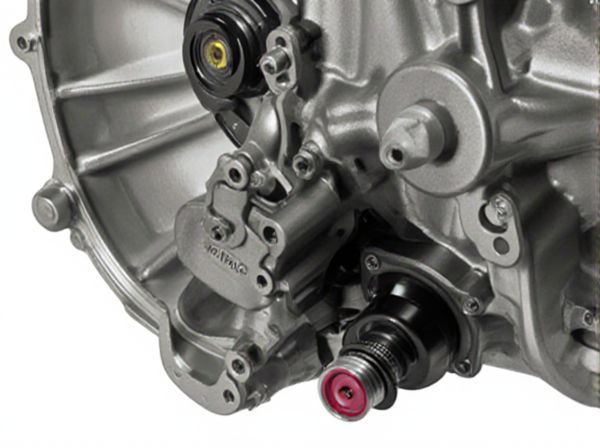
Photo illustration: Direct-shift vs Tiptronic
Direct-shift transmissions (DCT) provide faster gear changes and improved fuel efficiency by using two separate clutches, making them ideal for performance-oriented driving. Tiptronic systems offer manual gear selection within an automatic transmission, allowing more control without the need for a clutch pedal. Your choice depends on whether you prioritize seamless speed or the feel of manual shifting with convenience.
Table of Comparison
| Feature | Direct-Shift Transmission (DCT) | Tiptronic Transmission |
|---|---|---|
| Type | Dual-clutch automated manual | Automatic with manual shift mode |
| Shift Speed | Extremely fast, near seamless | Moderate, traditional automatic speed |
| Fuel Efficiency | Higher efficiency due to reduced engine load | Moderate efficiency, less optimized |
| Driving Experience | Sporty, performance-focused | User-friendly, flexible manual control |
| Complexity | Highly complex, requires advanced maintenance | Less complex, easier to maintain |
| Cost | Generally higher initial cost | Generally lower cost |
| Common Use | Sports cars, high-performance vehicles | Luxury cars, mainstream automatics |
Understanding Direct-Shift and Tiptronic Transmissions
Direct-Shift Gearbox (DSG) employs dual clutches to enable lightning-fast gear changes without interrupting power flow, optimizing fuel efficiency and performance. Tiptronic is a type of automatic transmission that allows manual gear selection via the gear lever or paddle shifters, offering driver control without a clutch pedal. Understanding DSG's seamless shifting and Tiptronic's manual override benefits drivers seeking a blend of automation and engagement in their driving experience.
Key Differences Between Direct-Shift and Tiptronic
Direct-Shift Gearbox (DSG) offers seamless and faster gear changes using dual clutches for split-second shifting, improving fuel efficiency and acceleration. Tiptronic systems provide manual control over an automatic transmission, allowing drivers to shift gears via the gear lever or paddle shifters, enhancing driver engagement but lacking the dual-clutch speed of DSG. DSG prioritizes performance and efficiency through automated dual-clutch technology, whereas Tiptronic focuses on user-controlled gear selection within a traditional automatic transmission setup.
How Direct-Shift Gearboxes Work
Direct-shift gearboxes (DSG) use dual-clutch technology to enable lightning-fast gear changes by pre-selecting the next gear while the current one is engaged, minimizing power interruption. This system operates with two separate clutches--one for odd gears and another for even gears--allowing seamless transitions and improved fuel efficiency compared to traditional automatic transmissions like Tiptronic. Unlike Tiptronic, which relies on a torque converter and manual-like gear selection, DSG provides a more direct mechanical connection for quicker shifts and enhanced driving dynamics.
How Tiptronic Systems Operate
Tiptronic systems operate by allowing drivers to manually control gear shifts within an automatic transmission, using either the shift lever or paddle shifters, offering a blend of automatic convenience and manual control. The system electronically manages clutch engagement and gear changes, optimizing shift timing for smoother transitions and fuel efficiency. Unlike direct-shift transmissions (DCTs) that use dual clutches for rapid gear changes without torque interruption, Tiptronic relies on automatic transmission components with manual override features.
Performance Comparison: Direct-Shift vs Tiptronic
Direct-Shift Gearbox (DSG) delivers faster and more precise gear changes compared to Tiptronic systems, enhancing acceleration and overall vehicle responsiveness. DSG's dual-clutch mechanism allows seamless power transfer with minimal interruption, resulting in superior fuel efficiency and smoother driving dynamics. Tiptronic, while offering manual control over automatic transmissions, generally exhibits slower shift times and less optimized performance under high-demand conditions.
Driving Experience: Sportiness and Comfort
Direct-shift transmissions offer rapid, seamless gear changes that enhance sportiness by delivering quick acceleration and precise control, ideal for spirited driving. Tiptronic systems combine automatic ease with manual override, providing a balanced driving experience that prioritizes comfort while allowing occasional sporty engagement. Drivers seeking aggressive performance prefer direct-shift for its responsiveness, whereas those valuing relaxed cruising opt for Tiptronic's smoother, more adaptable shift patterns.
Fuel Efficiency and Economy Analysis
Direct-shift transmissions (DCT) offer improved fuel efficiency by enabling faster and more precise gear changes, reducing energy loss during shifts compared to Tiptronic systems, which rely on traditional automatic transmission mechanics with manual override capabilities. The dual-clutch design in DCT minimizes power interruption between shifts, optimizing engine performance and lowering fuel consumption in real-world driving conditions. Tiptronic transmissions provide smooth driving experience but often sacrifice some fuel economy due to less efficient torque converter operation and slower gear change response times.
Reliability and Maintenance Considerations
Direct-shift transmissions (DSG) offer faster gear changes and improved efficiency but require precise maintenance, including regular fluid changes and clutch adjustments to ensure reliability. Tiptronic systems, typically integrated with traditional automatic transmissions, have simpler maintenance routines and tend to be more robust over time due to fewer complex components. Choosing between DSG and Tiptronic hinges on balancing the higher maintenance demands of DSG with its performance benefits against the proven reliability and lower upkeep of Tiptronic systems.
Suitability: Which Transmission Is Right For You?
Direct-shift transmissions (DCT) offer rapid gear changes and high efficiency, making them ideal for drivers seeking performance and fuel economy. Tiptronic transmissions provide a blend of automatic convenience with manual control, appealing to those who prefer more driver engagement without sacrificing ease of use. Choosing between DCT and Tiptronic depends on your priority: sportier, precise shifts with DCT or versatile, user-friendly operation with Tiptronic.
Future Trends in Automatic Transmission Technology
Direct-shift transmissions (DCT) continue to advance with improved clutch control algorithms and reduced shift times, enhancing fuel efficiency and driving performance for electric and hybrid vehicles. Tiptronic systems evolve through integration with adaptive software that tailors shift patterns to driver behavior and road conditions, promoting smoother gear changes and increased driving comfort. Future automatic transmission technology emphasizes seamless hybridization and AI-driven control systems, blending the quick responsiveness of DCT with the intuitive manual override capabilities of Tiptronic for optimized efficiency and performance.
 caratoz.com
caratoz.com